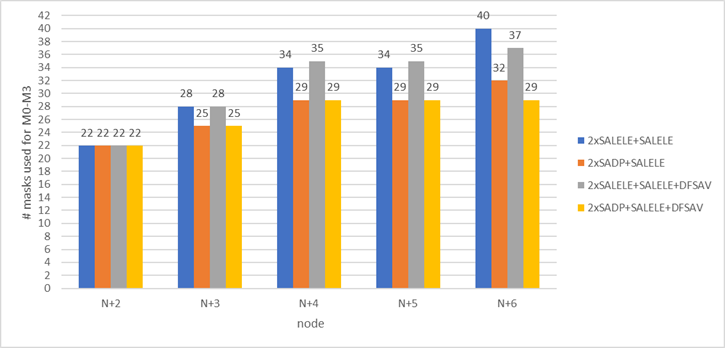CEVA Webinar “Challenges of Vision Based Autonomous Driving & Facilitation of An Embedded Neural Network Platform” will be held on November 16[SUP]th[/SUP] and will address one of the hottest topics today in our industry, probably the hottest in the automotive industry as all the players are working hard on autonomous vehicles.… Read More
 Kirin 9030 Hints at SMIC's Possible Paths Toward >300 MTr/mm2 Without EUVEarlier this month, TechInsights did a teardown of…Read More
Kirin 9030 Hints at SMIC's Possible Paths Toward >300 MTr/mm2 Without EUVEarlier this month, TechInsights did a teardown of…Read More Why TSMC is Known as the Trusted FoundryTaiwan Semiconductor Manufacturing Company (TSMC) is widely regarded…Read More
Why TSMC is Known as the Trusted FoundryTaiwan Semiconductor Manufacturing Company (TSMC) is widely regarded…Read More Journey Back to 1981: David Patterson Recounts the Birth of RISC and Its Legacy in RISC-VIn a warmly received keynote at the RISC-V…Read More
Journey Back to 1981: David Patterson Recounts the Birth of RISC and Its Legacy in RISC-VIn a warmly received keynote at the RISC-V…Read More Assertion-First Hardware Design and Formal Verification ServicesGenerative AI has transformed software development, enabling entire…Read More
Assertion-First Hardware Design and Formal Verification ServicesGenerative AI has transformed software development, enabling entire…Read More TSMC's Customized Technical Documentation Platform Enhances Customer ExperienceTaiwan Semiconductor Manufacturing Company, the world's leading dedicated…Read More
TSMC's Customized Technical Documentation Platform Enhances Customer ExperienceTaiwan Semiconductor Manufacturing Company, the world's leading dedicated…Read MoreExecutive Interview: Vic Kulkarni of ANSYS
Having known Vic for many years, it is always great to spend time with him and catch up on what is happening inside the semiconductor ecosystem. As Senior Vice President and General Manager, RTL Power Business, at ANSYS in Silicon Valley, Vic spends a lot of time in the field with customers, partners, and at industry events so he has… Read More
What’s Really Going to Limit the IoT?
There’s a lot of hype about the Internet of Things (IoT) as anyone who’s reading anything about these days already knows. There’s wearable tech, there’s healthcare IoT, there’s M2M IoT and a host of other areas of the IoT that are all projected to explode over the next 10 years. Billions and billions of devices are forecast.
Those … Read More
The Fastest Route to V2V
As an occasional rider of the rails in the U.K., I am charmed by the unusual station names. Unfortunately my exposure is limited for the most part to the short run from Euston Station in London to Milton Keynes – the planned city regarded with great disdain by most Brits.… Read More
New IoT Botnets Emerge
On the heels of severe Distributed Denial of Service (DDoS) attacks, new Internet-of-Things (IoT) powered botnets are emerging. There are already hundreds of such botnets which exist in the underground hacking ecosystem, where services, code, and specific attacks can be purchased or acquired. New botnets are being developed… Read More
Let’s Talk About Cyber Risks
In the last 12 months, we have seen an unprecedented number of cyber-attacks occur or come to light. Sophisticated attacks against governments, businesses, consumers, and the pillars of the Internet itself. The future appears to be fraught with run-away risks. Can security tame data breaches, ransomware, massive DDoS assaults,… Read More
Automotive Semiconductor Safety
One of the more telling trends in the semiconductor industry is the “fabless systems companies” transformation. Systems companies that used to buy chips are now making their own to better control the system they are designing: from the chip, package, PCB, the complete system. Apple is the best example as they are now one of the most… Read More
Is FPGA Intel Next Big Thing for IoT ?
I write this article in reaction to another article from Seeking Alpha titled “Intel Next Big Thing”. I have extracted this from the article:
The IoT space is growing rapidly with the advent of connected cars, smart homes and a variety of connected devices and appliances. However, before a full-blown ecosystem around these devices… Read More
EUV transition comes into focus
We attended ASML’s analyst day in New York on Halloween. We were very impressed with the quality, content and clarity of the presentations and thought it was one of the best strategic positioning presentations we have seen in the semi industry. We also had an opportunity to meet with several members of senior management after… Read More
RRAM Redux
Advanced memory technologies are a perennially hot topic thanks to a proliferation of data-hungry applications pushing our demand for more capacity and performance at less power and area. Among several technology contenders is Resistive RAM or RRAM (also called ReRAM). In this technology a conducting filament is grown through… Read More




Quantum Computing Technologies and Challenges